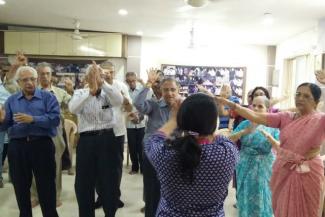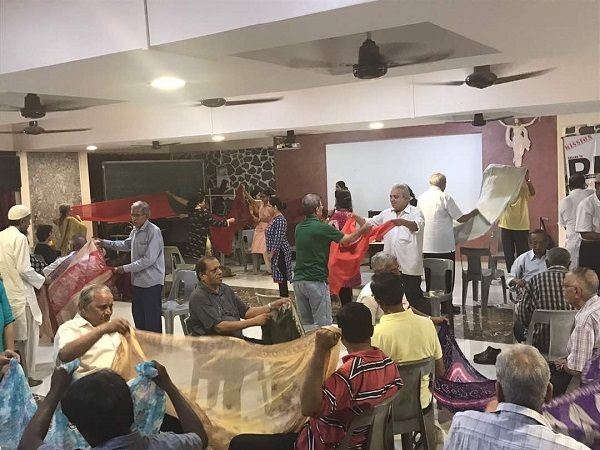
Dance and Movement Therapy can effectively complement traditional exercise to improve motor, psychological, cognitive and social abilities of people with Parkinson’s. Tejali Kunte, Clinical Psychologist, Dance and Movement therapist at Parkinson’s Disease and Movement Disorder Society (PDMDS) delves into its numerous advantages.
Tejali, you are a dance and movement therapist and a clinical psychologist. Could you tell us a little bit about your work?
Yes, I am a dance performer, clinical psychologist and a dance/creative movement therapy facilitator. Training in these three allied fields helps me a lot in my work of psychotherapeutic intervention and community rehabilitation. Currently I am working with the NGO- Parkinson’s Disease & Movement Disorder Society (PDMDS), Mumbai which provides free multidisciplinary services to people with Parkinson’s through a network of support group centres in our city and our country. I use creative movement therapy activities and skills along with psychotherapeutic interventions for people with Parkinson’s attending these groups. The two complement each other very well to aid in rehabilitation of people with PD.
What are the benefits of dance and movement on the symptoms of Parkinson’s disease(PD) and other neurological disorders?
Parkinson’s disease is a progressive neurological disorder which results from the deficiency of Dopamine neurotransmitter in the brain, which is primarily responsible for controlling body movements. Thus, PD is specified as a movement disorder and people with this condition experience different motor symptoms such as loss of balance, difficulty in walking, freezing, stiffness/rigidity in muscles, bradykinesia (slowness of movements), stooped posture, etc. But PD is not limited to motor symptoms. People with PD also often experience different non-motor symptoms such as depression, anxiety, hallucinations, difficulty with sleeping, etc. Dance is one of the powerful ways which targets both motor and non-motor symptoms of Parkinson’s and helps improve these symptoms. Along with improving motor, non-motor (psychological), cognitive and social functions; dance often aims at improving an overall quality of life of people with PD and other neurological conditions.
What kind of dance/movement is advocated at such therapeutic sessions?
Usually in Dance and Movement Therapy sessions, we do not use any particular dance style but instead encourage the natural, free movements of the participants. Aim of dance therapy is not really to teach dance style or techniques; but to use dance and movement as a medium of expression and a tool for therapeutic intervention. In dance sessions with people with PD, we use some techniques from different dance styles which would help them deal more effectively with their symptoms. Along with these dance techniques, we also promote the use of free, natural and creative movements in the session. As we know, dance is a culturally rooted art form; people relate to it more when we use a culturally specific dance form. Hence in India, we use different techniques from various Indian classical and folk dance styles such as Kathak, Bharatnatyam, Garba, Bhangra, etc. I am professionally trained in Kathak and Bhartanatyam so I use the aspects of these dance styles that would have therapeutic benefits and fit in with the symptoms of PD. For example, the concept of hand gestures (Hasta Mudra) from Indian classical dance styles is used to help people with PD improve their fine motor movements, and the concept of Navrasa (9 emotions) can be used to overcome masked face in PD.
Related Reading: Kathak Dance aids mobility of Parkinson’s and Arthritis patients
Similarly in western countries, different dance styles like Tango, Jazz, Waltz, Ballroom dancing, etc. have been used extensively with people with PD and these dance styles have shown significant improvements in the participants.
Parkinson’s disease is a progressive, neurodegenerative disorder that is often accompanied by impaired balance, walking and lack of muscle control. Do you think the fear of falling could limit dance therapy?
Yes, as you rightly said; in Parkinson’s disease, balance, walking are impaired and may limit different activities of daily living but that does not limit their participation in Dance therapy sessions. They may not be able to do all the movements freely as they used to do before but in dance sessions with PD; we use different modifications of dance steps and techniques which can be easily used by PwPs (people with Parkinson’s) at the same time ensuring their safety. Due to balance problems in PD, people often have fear of falling. But we use chairs, wall support or do the dance and movement activities in sitting which would ensure the safety and reduce the chance of falling during the dance session. People who are wheelchair users can also be a part of dance sessions and enjoy it as much as the other people do!!
Is dance therapy also applicable for those with advanced Parkinson’s disease?
Yes, absolutely! People with advanced PD can also take part in dance therapy sessions but we have to be careful to ensure their safety. They may not follow all the steps in the group, or may take longer to comprehend instructions; hence individual dance sessions can also be an option for them. Dance and movement activities change according to the stage of the person with PD. Fast paced and slightly challenging dance steps can be done with people at the initial stage of PD, but in later stages; we use soft, slow paced movements.

Are there any neurological benefits of dance? Does it provide any stimulation for cognitive functioning?
Dance and movement sessions provide various benefits for people with PD and these findings are backed up with scientific research studies which indicate that dance has different neurological benefits. In an article published by the Harvard Medical school titled ‘Dancing and the brain’, it stated that, ‘Studies using PET imaging have identified regions of the brain that contribute to dance learning and performance. These regions include the motor cortex, somatosensory cortex, basal ganglia, and cerebellum. The motor cortex is involved in the planning, control, and execution of voluntary movement. The somatosensory cortex, located in the mid region of the brain, is responsible for motor control and also plays a role in eye-hand coordination. The basal ganglia, a group of structures deep in the brain, work with other brain regions to smoothly coordinate movement, while the cerebellum integrates input from the brain and spinal cord and helps in the planning of fine and complex motor actions.’
Hence it is evident that dance provides brain stimulation and helps improving one’s cognitive functioning. In PD, lower levels of neurotransmitters such as Dopamine and serotonin are observed to be associated with depression. PET scans after dance sessions indicate the increase in the levels of dopamine, serotonin and release of Endorphins (happy hormone) which contritute to the feeling of happiness, and relieve depression in PD. Release of Endorphins also helps in increasing pain threshold, reduces stress and thereby resulting in elevated mood state. To overcome freezing in PD, people often use different auditory and visual cues. These cues are postulated to bypass the dysfunctional basal ganglia (where the brain cells produce dopamine) and utilize alternate pathways. Dance serves auditory cues using music and visual cues using dance steps to aid movement. Auditory cues may bypass the basal ganglia and access the supplementary motor area via the thalamus or they may access premotor cortex via the cerebellum. These brain research findings explain the neurological basis for the benefits of dance and how it promotes cognitive functioning in Parkinson’s.
How does dance/movement therapy score over conventional physiotherapy or traditional exercises?
Every therapy has its own unique features and stands out from other therapies. Dance/Movement therapy scores over conventional physiotherapy and traditional exercise programs because of the nature of this therapy and its salient features. Dance/creative movement therapy program uses music, various props such as balloons, ribbons, balls, etc. in the course of the therapy session which may not be part of physiotherapy sessions. Use of music and such props help to keep the group active and participants find it more interesting to exercise along with the music/props. Some find it boring or monotonous to exercise to the count of numbers as it is done in traditional exercise/physiotherapy programs; so people tend to be irregular with their exercises and not motivated enough to exercise regularly.
Related Reading; Try Group Drumming for the Elderly
On the contrary, in dance sessions with the help of the music, people forget about the number of counts they are doing a particular exercise and enjoy it even more. Participants often report that, this kind of exercise regime to music can be more fun and relaxing. Also we keep changing the music, exercise routine which keeps the group motivated and they look forward to the next session.
Conventional physiotherapy or traditional exercise program is usually conducted one-on-one; but more often dance sessions are conducted in a group setting. Lack of socialization is also linked to depression in elderly and Dance being a sociable form of exercise; it specially has the potential to exert positive benefits of mood from dance sessions. Group setting of these sessions make it more interesting as people get to interact with each other, dance together, and share joy and happiness with others in the group. These creative and unique features of dance or creative movement sessions seem to improve the regular attendance of the group and thereby giving them an opportunity to exercise regularly! Dance and movement therapy is one of the excellent complementary or adjunct therapy options for people with Parkinson’s.
What improvement has been noticed in patients? Could you give us specific examples?
Improvements on various parameters have been noticed in PwPs after the dance and movement sessions. We have noticed improvements in their physical, psychological and cognitive symptoms. People with Parkinson's often have masked face due to stiffness of facial muscles and lack of facial muscle exercises. So it is difficult for them to express their emotions, which leads to problems in interpersonal communication. After dance sessions, we have observed a difference in the way they used to express their emotions. Some of our participants reported the benefits of dance sessions to help them overcome masked face and expressing their emotions better, using facial expressions. One PwP reported that; “The dance sessions were useful to improve my balance, gait, movement and cognitive functions. I practise Navarasas (9 basic emotions as per Indian literature) in front of a mirror occasionally to improve the facial expressions which were taught in the dance sessions" and another participant said that, "In Parkinson’s, our faces become almost expression-less but with the help of dance therapy we have started expressing our emotions better. In every dance therapy session, we learn something new and our attention, balance improved without conscious efforts. I also felt improvement in my walking and other transfers of daily living". They also noticed the differences in their walking, balance and posture. Using dance and rhythm activities, they learned some tips to overcome freezing, which is a common complaint in PD. One of our PWPs reported that, ‘I found dance classes to be useful to overcome freezing, improve balance, reduce tremors in legs and nervousness in the body. Dance sessions also motivated me to communicate with other people, enhanced positive thinking and I also felt energized after attending these sessions. Dance therapy specially helped people like me, with PD to have better mental, physical and emotional well-being’. These subjective experiences and reports of the people who attended the dance sessions along with objective evaluation and observations by therapists helped us conclude the impacts of dance therapy for Parkinson's.
The Parkinson’s Disease & Movement Disorder Society (PDMS) has undertaken a research to understand the impact of dance therapy on Parkinson’s. Could you share with us some of its findings?
PDMDS in association with Bombay Hospital Research Trust, Mumbai had undertaken a research study to understand 'the effects of creative dance and movement group intervention program using Indian dance techniques on people with Parkinson's.' We had one group (control group) who continued with the regular group exercise program at our support group centre and another (experimental) group participated in a dance intervention program. The study was carried out for 3 months. Participants were assessed for their physical functioning, cognitive abilities, non-motor symptoms: anxiety and depression, mood and quality of life; pre and post intervention period using standardized tests for each domain.
The main trend observed in our findings, was about the difference in Mood of participants in two groups after the intervention period. Participants in Dance intervention group reported to have better mood as measured by PANAS (Positive and Negative affect scale) and HADS (Hospital anxiety and depression scale) as compared to participants in traditional exercise group.
Do you think all creative exercises like drumming, drawing, singing, etc have a similar impact on Parkinson’s?
All creative and expressive art therapies like drumming, drawing, singing, etc. offer various therapeutic benefits; but they do change according to the mode of therapy we are applying. Dance and movement therapy offers motor, psychosocial, cognitive benefits whereas singing focuses more on improvement of speech in people with Parkinson's. Drawing seems to provide more benefits for improving fine motor movements of PwPs. Apart from these therapy specific benefits, almost all creative therapies seem to have an impact on the mood of the people with Parkinson's and help them relive stress, tension as they engage in such expressive art therapy activities.
What is the scope of dance and movement therapy with people with Parkinson's in India?
In India, there is an increasing population with neurological disorders like Parkinson's Disease and people have started realizing the importance of supportive therapies for these conditions. Dance and movement therapy is a relatively new and emerging field in India but it seems to be growing at a rapid pace. We need to engage in more number of scientific research studies to understand the benefits of dance and movement therapy programs for PwPs in India and also replicate the research study model to different parts of the country to check for the generalizability. With the increasing number of people being diagnosed with Parkinson's in India, the scope of dance and movement therapy with people with PD is also widening! We have started realizing the power of dance and movement for Parkinson's in India and the importance of doing research in this field. Collective efforts of different dance and movement therapy facilitators across the country would definitely add to reaching out to more people with Parkinson’s and making these services available for them.
We have begun and have a long way to go!!
Images provided by PDMDS







